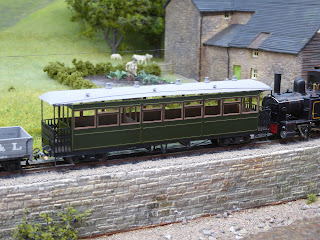The V hanger was also from Roxey Mouldings and then the step was fabricated from 0.5mm brass wire and some etch sprue from the box. In theory tinning of components and careful placement should make it easy but reality says there are two or three attempts before getting it right.
By now you may be wondering why Flying Tigers. I was struggling to hold the carriage and I didn't want to put it on a flat surface as that might squash the fittings on the bottom facing side. I hit on using these two wooden pallets to support the carriage. They are probably 1/12 scale and came from Flying Tiger, one of those shops that has all sorts of bits you never knew you needed. Hopefully it is clear from the picture how I am using them. I'm not sure if the pallets are still available as I have had mine for a while.
The real advantage is that they are hollow at the side so the application of a clamp and a piece of wood and the carriage is clamped to the pallet and held robustly without damaging any fittings. Hopefully this picture from the opposite direction shows how they have been utilized. Unfortunately the picture also shows where the paneling is marked but hopefully that will not be so obvious once painted.







